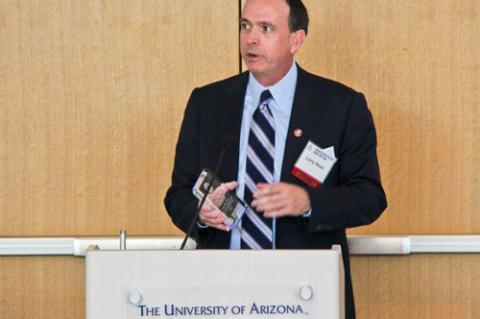Larry Head Named Leading Edge Researcher at 2012 UA Innovation Day
Professor Larry Head, systems and industrial engineering department head, was named a leading edge researcher March 6 at UA Innovation Day.

Head's research in traffic and transportation systems engineering is currently focused on priority-based traffic signals that can reduce fatalities among fire and rescue first responders.
Nearly 13 percent of the firefighters and police officers who die in the line of duty are killed in vehicle-related incidents, and fire trucks are involved in ten times as many collisions as other heavy trucks.
Head is working with the Maricopa County Department of Transportation in an attempt to reduce these deaths by creating a system that will make intersections safer for emergency responders and the general public.
"I'm honored to be recognized as a Leading Edge Researcher," Head said. "Usually transportation is not considered to be a cutting edge area for research, but our work should be able to help save lives of our first responders and make traffic systems safer and more efficient."
A prototype has been installed at six intersections in Anthem, Ariz., and a demonstration and press event are scheduled for April 2012. Head says the system being installed in Maricopa County could be one of the first steps in deploying a smart-vehicle system throughout the country. "I am also grateful for our partners at Maricopa County, ADOT, and City of Tucson," Head said. "Without their support we would not be able to pursue this area of research."
For more information on Head's smart traffic systems, see: UA Engineers and Local DOT Test Smart Traffic Systems to Reduce First Responder Deaths, Arizona Engineer Online, March 22, 2011.
After the leading edge researchers were announced, the Technology Innovation Awards Luncheon honored an outstanding faculty member and student for their achievements in translating original ideas from the laboratory to the marketplace.
A special video, "Thinking the Impossible," premiered during the luncheon and highlighted how the UA has been a global leader in scientific and technological innovation for more than a hundred years.
Following the luncheon, the Innovation Showcase allowed participants to meet with UA departments, start-up companies from the Arizona Center for Innovation, and to get a preview of the business plans of students from the McGuire Center for Entrepreneurship.
The Office of University Research Parks and the Arizona Center for Innovation organize Innovation Day in partnership with the UA's senior vice president for research, UA External Relations, Office of Technology Transfer, and the McGuire Center for Entrepreneurship. Innovation Day's title sponsor is Research Corporation for Science Advancement. Other sponsors are Arizona Commerce Authority, Arizona Tech Council, BizTucson, Hecker and Muehlebach, Strategy 1, and Tucson Electric Power.
Innovation Day at the UA is an official Arizona Centennial Event and a signature event of the Arizona SciTech Festival.
Other leading edge researchers named at Innovation Day were:
- Eric A. Betterton, for his research exploring an atmospheric model to forecast wind-blown dust from natural and man-made sources, which supports the development of dust-forecasting technology for health and traffic advisories.
- Leslie Gunatilaka, who explores novel compounds synthesized by exotic plants from the arid zones of Asia, South America and the Sonoran Desert, and evaluates them for medicinal value.
- Sharon Megdal, for her work on state and regional water resources management and policy, which contributes to improved development and understanding of state water-management strategies.
- James T. Schwiegerling, who is developing a design for an accommodating intraocular lens, which behaves just like the flexible human lens in the eye, and can be used as a replacement in cataract surgery.


8824.jpg?itok=9L_Qjz02)